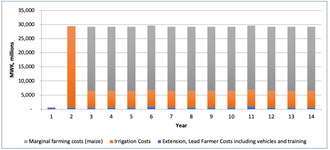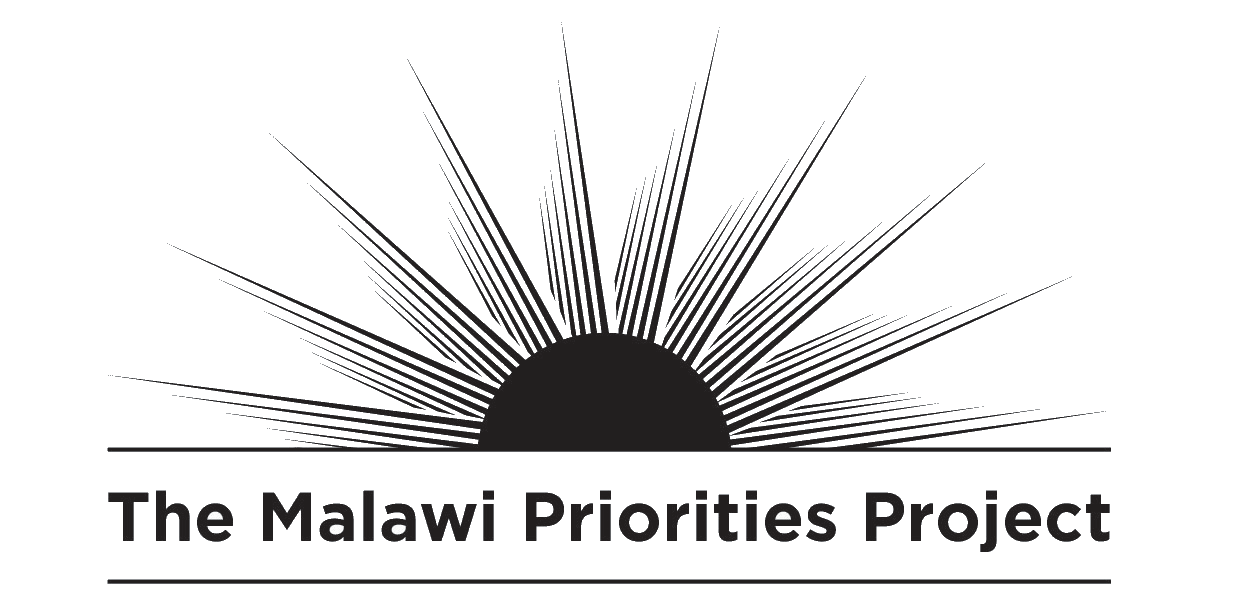Malawi Priorities: Agriculture: Irrigation
Technical Report
Key Messages
- Expanding irrigation has been a key policy goal of Malawian governments for decades. Irrigation schemes, including flagship projects, have shown a pattern of high costs that exceed the likely gross margin gains from irrigation. For example, the Irrigation Master Plan notes upfront costs of USD 18,500 and ongoing costs of USD 2,400 per extra hectare irrigated, figures substantially higher than the likely profit from irrigated farming under current conditions in Malawi.
- The primary takeaway from this cost-benefit analysis conducted on irrigation interventions in Malawi remains that policymakers need to pay very close attention to the costs of irrigation technologies and the choice of commodities promoted. The costs of irrigation technology and the returns to irrigated crops can vary substantially. Crops that have higher gross margins and are more susceptible to water availability are more likely to yield profits that cover the costs of irrigation investments.
- Tomato, paprika, and to lesser extent cassava appear to fare well under irrigation, with gross margins large enough to cover the cost of irrigation investments, resulting in relatively higher benefit-cost ratios (BCRs). This highlights the importance of increasing crop diversity, simultaneous with irrigation promotion, to maximize benefits.
- The findings of the research also show that relatively inexpensive gravity irrigation generates larger BCRs than its more expensive counterpart, solar irrigation.
Context
Creating wealth through agriculture has been a long-running development goal in Malawi. Within the country, irrigation is viewed as a valuable opportunity and has increased substantially for smallholder farmers, quadrupling from 15,988 ha in 2011 to 61,977 ha by 2019. It has the potential to open up the dry season for cultivation on a grand scale, comparable to rainy season harvests, while also stabilizing wet season cultivation, insuring yields against variable rainfall patterns. As such, it can provide a good opportunity for farmers – particularly the very large number of smallholders in Malawi – to increase their income and standard of living. Irrigation holds a prominent place in Malawi’s 2063 vision, with the hope that it “caters for national food security needs, supports agriculture commercialization, and promotes exports.”
The Greenbelt Initiative (GBI), launched in 2011, aims to increase agricultural production while targeting approximately one million hectares of land along Lake Malawi and Malombe, the Shire River, and the perennial rivers right from Chitipa to the Shire Valley. The food crops targeted by the GBI include maize, rice, cassava, potatoes, pulses, millet, and sorghum whilst the cash crops will include cotton, sugarcane, and wheat, in addition to other fruits, vegetables, and spices for which Malawi may have a comparative advantage.
These efforts of the GBI are supported by a comprehensive policy framework consisting of the National Resilience Strategy (2018-2030); the National Irrigation Policy (2016); and the Programme for Rural Irrigation Development. Notwithstanding strong national interest in irrigation, encouraging farmers to take up and use irrigation remains a challenge. Four factors that affect farmer adoption of irrigation are the affordability of irrigation equipment, access to financing, the quality of extension services, and access to water. The importance of these challenges is confirmed by the National Irrigation Policy (2016), which identifies inadequate financial resource mobilization and high development costs among the primary constraints. Furthermore, additional challenges include a lack of knowledge about how to use and maintain irrigation technology, as well as vandalism and theft.
The constraint around cost at the farmer level is similarly mirrored at the national policy level as well. Irrigation projects are expensive, requiring economies of scale, consistent water supply, credit or grants, and available markets for products to reduce or justify costs.
Summary of Findings
The study focuses on the areas around Lake Malawi and Shire Valley. Overall, two interventions were considered as ways to increase the area under irrigation:
- Reorientation of extension services leading to uptake of gravity irrigation by smallholder farmers; and,
- Use of financial instruments, particularly matching grants, to help finance solar-powered irrigation schemes for estate farms and smallholder farmers in farmer organizations.
The study assumes reorientation of services compels 5% of smallholder farmers in the target areas to adopt gravity irrigation (56,000 ha). The use of financial instruments leads to 10% of estate farmers (44,000 ha) and 15% of smallholder farmers adopting solar irrigation (188,000 ha). While these are in line with historical evidence, sensitivity analyses show that the uptake rate has a minimal effect on the BCR.
Following existing studies, the research also assumes that irrigation enables smallholder farmers to expand the area under cultivation during the dry season from an average of 0.27 ha to 0.98 ha, and estate farms to expand their area of cultivation from 48% to 90% of potential area. Additionally, it is expected that irrigation will reduce the variability of yield in wet season crops, as irrigation can act as insurance against lack of rainfall.
The research considered a variety of crops to illustrate the potential differences in BCRs. Noting that one major constraint is market access, the research focused on a set of crops for which there appeared to be a pre-existing market with potentially unmet domestic or export demand. Based on these criteria, the crops selected for consideration were maize, wheat, rice, groundnut, pigeon pea, soybean, tobacco, cotton, paprika, chilies, cassava, and tomato. In both interventions,100% of the benefits are economic.
Intervention 1: Increasing the number of Agricultural Extension Development Officers (AEDOs) for better coverage, leading to an expansion of gravity irrigation among smallholder farmers
The first intervention assessed by the research focuses on reorienting extension workers and improving service provision of AEDOs and Lead Farmers (LFs) to provide better and more market-orientated information on irrigation usage for smallholder farmers. There are some challenges with agricultural extension services in Malawi currently. There are not enough extension workers to reach farmers, they need to be better trained and they also need more motorcycles to be able to travel to farms. They currently work through a network of Lead Farmers, a system that can be very useful but needs to be revitalized. Bearing in mind this context, this proposed intervention seeks to: 1) decrease the ratio of farmers to AEDOs to 1500:1; 2) reorient the work of AEDOs towards farm income growth rather than yield maximization; 3) improve their mobility by purchasing motorcycles for every 4 AEDOs; and, 4) revive the Lead Farmer model, by using LFs for last-mile extension services and to offer them financial incentives for their organization of demonstration days and outreach.
Figure 1: Costs of extension officer reorientation with a focus on maize for illustrative purposes. The marginal costs of other crops are presented in the technical report

Improving these factors is assumed to increase the area under dry-season cultivation by 5%, which is likely to be the bottom of the actual range. Given the lack of financial support, it is also assumed that farmers will adopt the least-cost technology, gravity. The benefits which accrue will depend upon the crop cultivated. Improving extension services would of course also have other benefits to farmers, who would then receive better advice, but these additional benefits have not been fully estimated.
The costs of this intervention fall into three broad categories: 1) costs associated with the intervention changing and increasing the number of AEDOs, 2) irrigation infrastructure and maintenance, and 3) marginal change in costs associated with a greater area of cultivation. With regards to the irrigation infrastructure, FAO (2014) estimates the fixed cost for a gravity system at MWK 520,000 (USD 700) per hectare and operation and maintenance costs at MWK 104,000 (USD 140) per hectare annually. The primary cost is the cost of cultivation associated with the increased cropped area. A substantial investment is also required for irrigation in year 2. In contrast, the additional cost of improving extension workers, including lead farmer incentives, is relatively small. There are two anticipated benefits of irrigation. First, there is the change in output associated with expanded cropping during the winter season. This typically represents the largest benefit component of the intervention. Secondly, there are the avoided losses in yield variability resulting from inadequate rainfall during the wet season. The research highlights that irrigation of both tomato and paprika would be beneficial within this intervention, with BCRs of around 5-6 in both cases. Cassava, a staple crop, also sees a good yield increase and fairly good BCR of 3.3, however, the post-harvest losses of this crop are high and the growing season is relatively long. The returns to irrigated maize do not appear to pass a benefit-cost test.
Intervention 2: Provide financing and grants to smallholder farmers and estate farms for solar irrigation pumps
The intervention proposed is a matching grant/credit combination of financial instruments to stimulate uptake of irrigation technology among both estate and smallholder farmers. Due to the difficulty of accessing funding or an unwillingness to bear the associated risks, the research considered the option of providing preferential financing from the government to Farmers Organizations that can spread the risk and help to get members’ produce to market at favorable prices. The research demonstrates that the high cost of solar irrigation pumps makes achieving a positive return on investments challenging. Tomato, paprika, and cassava appear to be the only commodities that would yield more benefits relative to costs under solar irrigation pumps.
Within this intervention, costs fall into three broad categories: 1) irrigation infrastructure and maintenance 2) the costs associated with monitoring and management of the financing instrument, 3) the marginal change in costs associated with a greater area of cultivation. In terms of irrigation infrastructure and maintenance, the average cost of a solar PV-powered pumping system is MWK, 4.2 million (USD 5,713) per hectare, and includes a water storage facility. The main cost of this intervention is the upfront costs of solar pumps.
Figure 2: Cost profile for financing and matching grants for solar irrigation, estate farms assuming uptake of 43,000 hectares with a focus on maize. Note cost profile continues for 20 years but is truncated at year 10 since the profile is the same each year

Figure 3: Summary of benefit-cost ratios of different interventions and crops, ranked from least cost-effective to most cost-effective

Summary Table
| Intervention | BCR | Beneficiary Group and expansion of area under irrigation | Irrigation investment cost | Benefits |
|---|---|---|---|---|
| Reorientation of extension services leading to uptake of gravity irrigation | Fair BCRs mostly between 1 and 5 (returns vary by crop) | Smallholder farmers 56,000 ha | MWK 30,000 million upfront MWK, 5,900 million ongoing |
MWK 13,000 million to MWK 280,000 million per year in increased crop production (benefits vary by crop) |
| Use of financial instruments, matching grants, to help finance solar-powered irrigation schemes | Poor BCRs mostly below 1 (returns vary by crop) | Estate farms 46,000 hectares | MWK 188,000 million upfront MWK 15,900 million ongoing |
MWK 3,500 million to MWK 194,000 million per year in increased crop production (benefits vary by crop) |
| Use of financial instruments, matching grants, to help finance solar-powered irrigation schemes | Poor BCRs mostly below 1 (returns vary by crop) | Farmer organizations 118,000 hectares | MWK 797,000 million upfront MWK 67,800 million ongoing |
MWK 46,000 million to MWK 933,000 million per year in increased crop production (benefits vary by crop) |
Note: BCRs are based on costs and benefits discounted at 8% (see accompanying technical report). BCR ratings are determined on the following scale Excellent, BCR > 15; Good, BCR 5-15; Fair, BCR 1-5; Poor, BCR < 1. This traffic light scale was developed by an Eminent Panel including several Nobel Laureate economists for a previous Copenhagen Consensus project that assessed the Sustainable Development Goals.
Download the full policy brief here.

